
I decided to use our garden because I spend a lot of time in it, and I know I really will. This garden is very big, around 800 meters. which is located in Halifax, N.S. There is nothing planted in it, but there are trees on two sides (big ones). There is one side of the grapes that is bored between us and our neighbour. The house is kind of centred in the middle, and we have parking in the front. We have not cut the grass for a while, and I realized three main things in our garden and would love to look more into them and see what is happening. However, we live in the centre of the city, where our house is right in front of the highway. There are neighbours on the sides and fronts. The ground never dries, even during the summer. There is a huge tree inside the garden that is very old, more than 20 years ago. I am not sure if that is affecting anything in the garden. Those pictures were taken on July 2nd, 2024. The temperature was 28 °C, mostly cloudy; there was wind as well.
There are things on my mind that I always ignore, but I think now is the time to figure them out.
Which are:
- Why do different flower types and colours grow up with the grass even if we do not plant them? Also, there are different types of plants for which we have no idea how or why they show up.
- Our garden is not flat completely; there are areas deeper down on the back of the fence where the grass grows faster and stronger than it once was closer to the street. I am wondering why.
- As I mentioned, there are big trees kind of in the middle, but I realized that there are no flowers or different types of plants around them. Why do the flowers grow only when there is no tree? Is it because of the shadow of the trees?
Hi, your backyard can certainly be used and numerous students have done backyard projects over the years. You need to keep in mind replication based on the size of your study area. Your questions all have potential, but remember to focus on your gradient for each one as you work towards one question to focus on and develop your study design. What is the gradient. For example, in question 1 there is no gradient associated with it. You won’t be able to say why plants grow where they do without more of an experiment. However, if you have a gradient of moisture / elevation / shade and there is variation in the types of plants along this gradient then you can at least say if they vary and what factors might be an influence.
In general, you could use more details on your gradients and your observations. How much does your garden vary in slope and over what distance? Have you noticed the grass growing faster there? What makes you think that is the case? Again, you might not be able to say why this is happening, but you can make measurements to confirm if it is the case and suggest in your discussion why it might be happening.
Also, remember to read over your posts for writing clarity and grammar. For example, what does it mean that the grass grows stronger? Also, in the start of your post I think you mean bordered and not bored. Overall, it is not clear to me if you are talking about a specific garden, which usually refers to a flower or vegetable garden or your whole yard with grass as you talk about the grass and the whole yard often and then refer to your garden which to me has a different meaning.
You also refer to pictures but I don’t see any and also don’t forget to post your field journal entries as part of your post when it is part of the instructions.